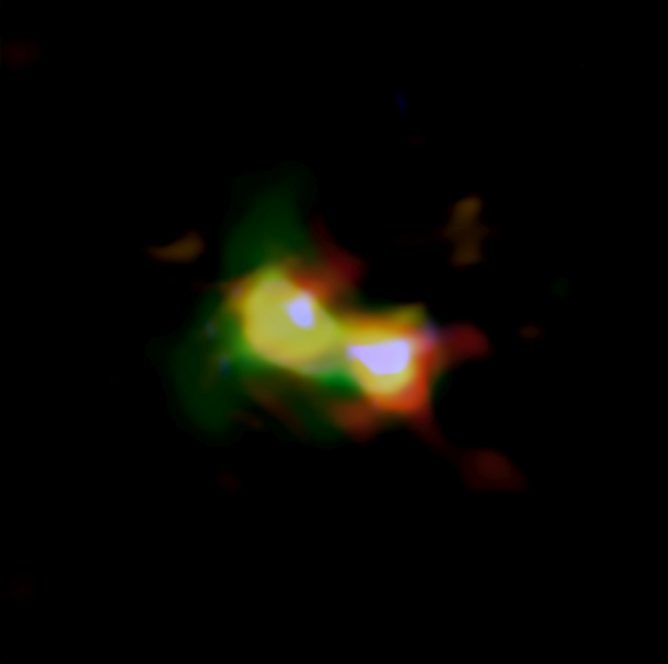Jun 18 2019
Scientists have detected signals of carbon, oxygen, and dust from a galaxy formed in the early Universe 13 billion years ago using Atacama Large Millimeter/submillimeter Array, or ALMA.
 Composite image of B14-65666 showing the distributions of dust (red), oxygen (green), and carbon (blue), observed by ALMA and stars (white) observed by the Hubble Space Telescope. (Image credit: ALMA (ESO/NAOJ/NRAO), NASA/ESA Hubble Space Telescope, Hashimoto et al.)
Composite image of B14-65666 showing the distributions of dust (red), oxygen (green), and carbon (blue), observed by ALMA and stars (white) observed by the Hubble Space Telescope. (Image credit: ALMA (ESO/NAOJ/NRAO), NASA/ESA Hubble Space Telescope, Hashimoto et al.)
This is the earliest galaxy in which this valuable combination of three signals has been observed. The researchers compared the different signals and identified that the galaxy is, in fact, two galaxies merging together, rendering it the earliest specimen of merging galaxies found to date.
Takuya Hashimoto, a postdoctoral researcher at the Japan Society for the Promotion of Science and Waseda University, and his colleagues used ALMA to look at B14-65666, an object found 13 billion light-years away in the Sextans constellation. Since light has a finite speed, the signals received currently from B14-65666 had to travel for 13 billion years before reaching Earth. Simply put, they demonstrate the image of how the galaxy looked 13 billion years earlier, less than 1 billion years following the Big Bang.
ALMA observed radio emissions from carbon, oxygen, and dust in B14-65666. This is the oldest galaxy from which all three of these signals have been observed. The observation of multiple signals is significant as they bear complementary information.
Analysis of data revealed that the emissions are split up into two blobs. Earlier detections using the Hubble Space Telescope (HST) had revealed two star clusters in B14-65666. Using the three emission signals observed by ALMA now, the researchers could demonstrate that the two blobs actually form a single system, despite having distinct speeds.
This shows that the blobs are two galaxies that are involved in the act of merging. This is the earliest known example of merging galaxies. The researchers predicted that B14-65666’s total stellar mass is less than 10% that of the Milky Way. This suggests that B14-65666 is in the earliest stages of its evolution.
In spite of the fact that it is young, B14-65666 has been generating stars 100 times more actively when compared to the Milky Way. An active star-formation such as this is another significant mark of galactic mergers since the gas compression in colliding galaxies naturally results in bursty star-formation.
With rich data from ALMA and HST, combined with advanced data analysis, we could put the pieces together to show that B14-65666 is a pair of merging galaxies in the earliest era of the Universe. Detection of radio waves from three components in such a distant object clearly demonstrates ALMA’s high capability to investigate the distant Universe.
Takuya Hashimoto, Postdoctoral Researcher, Japan Society for the Promotion of Science and Waseda University
Most recent galaxies such as the Milky Way have undergone innumerable, often intense, mergers. At times, a larger galaxy devours a smaller one. In exceptional cases, galaxies of comparable sizes merge to form a new, larger galaxy. Since mergers are crucial for the evolution of galaxies, a number of astronomers are keen on tracing back the history of mergers.
Our next step is to search for nitrogen, another major chemical element, and even the carbon monoxide molecule. Ultimately, we hope to observationally understand the circulation and accumulation of elements and material in the context of galaxy formation and evolution.
Akio Inoue, Professor, Waseda University
Paper and Research Team
The results of the observation were published as T. Hashimoto et al. “‘Big Three Dragons’: a z = 7.15 Lyman Break Galaxy Detected in [OIII] 88 um, [CII] 158 um, and Dust Continuum with ALMA” on June 18th, 2019, in the Publications of the Astronomical Society of Japan.
Following are the research team members: Takuya Hashimoto (Waseda University/Osaka Sangyo University/National Astronomical Observatory of Japan), Akio Inoue (Waseda University/Osaka Sangyo University), Ken Mawatari (Osaka Sangyo University/The University of Tokyo), Yoichi Tamura (Nagoya University), Hiroshi Matsuo (National Astronomical Observatory of Japan/SOKENDAI), Hisanori Furusawa (National Astronomical Observatory of Japan), Yuichi Harikane (The University of Tokyo), Takatoshi Shibuya (Kitami Institute of Technology), Kirsten K. Knudsen (Chalmers University of Technology), Kotaro Kohno (The University of Tokyo), Yoshiaki Ono (The University of Tokyo), Erik Zackrisson (Uppsala University), Takashi Okamoto (Hokkaido University), Nobunari Kashikawa (National Astronomical Observatory of Japan/SOKENDAI/ The University of Tokyo), Pascal A. Oesch (University of Geneva), Masami Ouchi (The University of Tokyo/National Astronomical Observatory of Japan), Kazuaki Ota (Kyoto University), Ikkoh Shimizu (Osaka University), Yoshiaki Taniguchi (The Open University of Japan), Hideki Umehata (The Open University of Japan/RIKEN), and Darach Watson (University of Copenhagen).
This study was supported by MEXT/JSPS KAKENHI (No. 26287034, 17H01114, 17H06130, 18H04333, 16H02166, 17K14252, JP17H01111, 16J03329, 15H02064, 19J01620), NAOJ ALMA Scientific Research Grant Number 2016-01A, Swedish National Space Board, Kavli Institute for Cosmology at the University of Cambridge, and Knut and Alice Wallenberg Foundation.